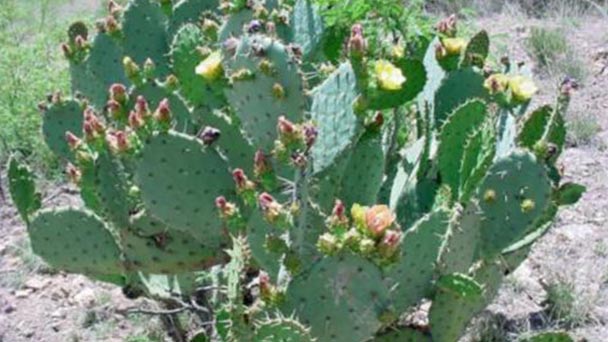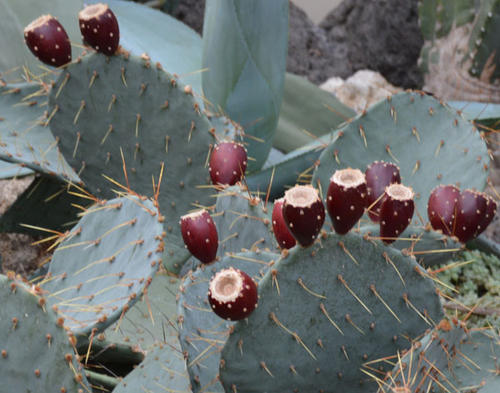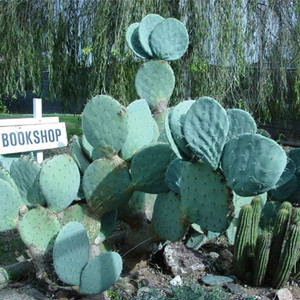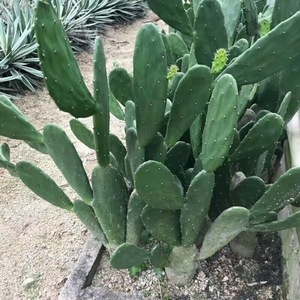Tulip prickly pear profile
Written by Maggie
Feb 08 2021

Tulip prickly pear, also called Opuntia phaeacantha, Desert prickly pear, is the cactus family, cactus genus perennial herbaceous pulpy plants. Tulip prickly pear is erect, 4 -- 5 m tall, nodules rounded or subrounded, nodules 15 -- 40 cm long, bluish-green, often pinkish. The spines are sparse, each spines have 8-12 spines, 5 cm long, white, yellow brown base. Spines are usually few and short in cultivation. The flowers of Tulip prickly pear are yellow and 5-7 cm in diameter. The fruit is oval and dark red. The Tulip Prickly Pear (Opuntia phaeacantha) is native to Mexico and the United States. The species has spread throughout North and South America and has been introduced into New Zealand and the Mediterranean region of southern Europe, South Africa, Madagascar, Australia and China. Tulip prickly pear grows in warm temperate and subtropical arid and semi-arid areas, mainly xerophytic and sedum vegetation, but also pine forests, oak forests and grasslands, growing well on shallow granite soil. Tulip prickly pear is a common indoor potted cactus ornamental plant, also suitable for exhibition greenhouse planting. The seeds are edible and suitable for feeding animals. Tulip prickly pear also has the function of purifying air.
Tulip prickly pear picture

Distribution and growth habits of the tulip prickly pear
The tulip prickly pear (Opuntia phaeacantha) is a plant that grows in the states of California, Utah, Texas, and Arizona in the northwestern part of Mexico.
Habits of the Tulip Prickly Pear: Sun-loving, desert areas ranging from 30 m to 1100 m (100 to 3600 ft) above sea level.
The plant form of the tulip prickly pear
Form of the Tulip Prickly Pear (Opuntia phaeacantha): The Tulip Prickly Pear is a cactus that grows in the southwestern United States and northern Mexico. It was a large, upright, fleshy shrub, covered with edible fruit and thick black spines. Its Latin scientific name, Phaeacantha, means "gray thorn". The appearance of Tulip prickly pear is characterized by a ridged axis on the flat green stem. The spine is brown, reddish brown, or gray. Often more than 3 cm in length. The thorn of Tulip prickly pear is brown. Flowers are from late spring to summer, light bowl shaped, bright yellow, peach, pink, or red, 7cm in diameter. The fruit of Tulip prickly pear is spherical to ovoid without spines and may be dark red, red, purple or green in color.
Tulip prickly pear propagation methods
Tulip prickly pear (Opuntia phaeacantha) propagation by cuttings. In the growing season, cut the full growing stem nodes with a sharp knife, then insert them into the plain sand after cutting. Pour 1 time after 7 days to permeate, often keep basin soil moist. Generally 20-30 days after the root, and then transplant on the pot.
Tulip prickly pear growing methods
Planting: Planting or changing soil in spring. In southern China Tulip prickly pear (Opuntia phaeacantha) can be planted on the ground, northern areas should be potted, indoor winter. Tulip prickly pear requires sandy loam, potted available garden soil 1, 1 leaf rot soil, coarse sand 1 mixed preparation of culture soil. Place new and replaced Tulip prickly pear (Opuntia phaeacantha) in a shaded place and let them stand for a few days before watering.
Light and temperature: In Tulip prickly pear (Opuntia phaeacantha) growing period put on the balcony or outdoor cultivation. Get plenty of light and good ventilation. If the light is insufficient and the water is too much, Tulip prickly pear (Opuntia phaeacantha) is easy to grow empty, the stem node becomes elliptical, reducing the ornamental value. Winter into the room, place Tulip prickly pear in the attached place, keep the temperature above 5℃. If the basin soil stays dry, it is hardy.
Watering and fertilization: In Tulip prickly pear(Opuntia phaeacantha) growing season spring topdressing 1 time decayed cake fertilizer water. Some superphosphate or compound fertilizer can be applied in autumn. Tulip prickly pear (Opuntia phaeacantha) early resistance is strong, growing season water 3-4 times a month, less water in winter, can water 1 times a month, keep the basin soil dry. Basin soil to see dry see wet, dry thoroughly pouring. Avoid watering too large, basin soil is too wet, otherwise easy to rot root death.

The role and use of the tulip prickly pear
Ornamental value
The Tulip Prickly Pear (Opuntia phaeacantha) is most cultivated as an ornamental and can be used to make small potted plants for indoor placement.
Purification effect
Keeping a Tulip Prickly Pear (Opuntia phaeacantha) indoors, especially a hydroponic cactus (because hydroponic cactus is cleaner for the environment), can have a cleansing effect. Tulip prickly pear is inhaled at night when it is cool and wet. When breathing, inhaling carbon dioxide, releases oxygen.
Radiation protection
Tulip prickly pear (Opuntia phaeacantha) grows in the tropics and has a strong absorption effect on strong light, including visible and invisible light. Electromagnetic radiation from computers and mobile phones is invisible light and is easy to be absorbed. The thorns of the Tulip prickly pear emit negative ions, which neutralize the harmful effects of positive ions. Tulip prickly pear placed near computer monitors suck only ash. Tulip prickly pears grow (Opuntia phaeacantha) well in places where sunlight shines and radiation sources are nearby. Small potted Tulip prickly pear (Opuntia phaeacantha) also has a role, just a matter of quantity, you can put a few pots. Computer radiation is the strongest zone is the keyboard, so a basin is put next to the keyboard is more appropriate, the back of the screen of the computer is also radiation to teach the strong zone.

Latest Updated
- Benefits of Bugleweed - 7 Science-backed Health Benefits
- Bugleweed Dangers & Side Effects - Is It Poisonous?
- How to Plant Evergreen Trees - What You Should Know
- When to Plant Evergreens - Grow Guide for Evergreen Trees
- 12 Wonderful Evergreen Shrubs for Your Garden
- 12 Popular Evergreen Plants with Pictures for Beginners
- When And How To Prune A Lilac Bush Like a Pro
- How to Grow & Care for Lilac Vine (Hardenbergia Violacea)
- Japanese Lilac Tree (Syringa Reticulata) Care & Propagation Guide
- Shumard Oak Pros and Cons - What to Know
Popular Articles
- Winter maintenance of Antirrhinum Majus
- How to Grow Terminalia Mantaly Tree
- How to Grow and Care for Crossostephium Chinense
- How to grow Antirrhinum Majus in spring
- Peristeria Elata (Dove Orchid) Profile: Info & Care Guide
- Underwatered Snake Plant (Sansevieria Trifasciata) - Signs And How To Fix
- How to Care for Brazilian Jasmine Plant (Mandevilla Sanderi)
- How to Grow & Care for Graptopetalum Purple Delight in Summer
- Rosa Chinensis (China Rose): Plant Growing & Care Tips
- How to Care for Baby Sun Rose (Aptenia Cordifolia)